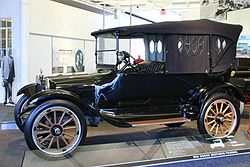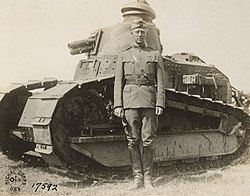George S. Patton
George Smith Patton, Jr. (also George Smith Patton III) (November 11, 1885 – December 21, 1945) was a U.S. Army officer who was in the army from 1909 to his death.[1] He was in charge of many soldiers and worked to defeat Nazi Germany during World War II in Europe.
He was sent to the North African Campaign in 1942 after the United States, led by Franklin D. Roosevelt, declared war on Nazi Germany after he Empire of Japan attacked Pearl Harbor on 7 December 1941 because Adolf Hitler and the Nazi Party supported Japanese Emperor Hirohito after Luftwaffe Commander Hermann Göring and Kriegsmarine Admiral Erich Raeder urged him to declare war on America.
Patton was also involved in the Allied invasion of Sicily, the Allied invasion of Italy, and the Normandy landings in some of the most severe fighting in the war. However, he also was involved in a series of slapping incidents.
Patton was born on November 11, 1885 in San Gabriel, California. He was married to Beatrice Banning Ayer from 1910 to his death; they had a son.
Patton died on December 21, 1945 after a car crash in Heidelberg, Germany, aged 60. He was later buried at American Cemetery and Memorial in Luxembourg City, Luxembourg. In the movie Patton, he was portrayed by George C. Scott.
George S. Patton Media
Patton at the Virginia Military Institute
Patton (right) fencing in the modern pentathlon of the 1912 Summer Olympics
The durability of the 1915 Dodge Brothers Model 30-35 touring car won renown for the new automaker following its use in the 1916 Pancho Villa Expedition[2]
Major General John J. Pershing, accompanied by Captain George S. Patton, inspecting men of Patton's headquarters troop at American Expeditionary Forces (AEF) headquarters, Chaumont, France, 1917
Patton at Bourg in France in 1918 with a Renault FT light tank
Tank Corps School near Langres, France, 15 July 1918. Tank crew receiving instruction from officers, from left to right: Captain Ranulf Compton, Chief Instructor, and Lieutenant Colonel George S. Patton (center, with back towards the camera), the Commanding Officer
Patton as a temporary colonel at Camp Meade, Maryland, 1919
References
- ↑ Carlo D'Este. Patton : A Genius for War HarperCollins, (1995).
- ↑ Jowett & de Quesada 2006, p. 25.









